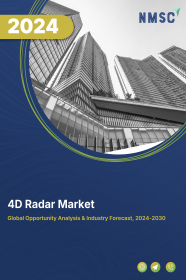
4D Radar Market by Automation Level (Level 1, Level 2, Level 3 to 5), by Range Type (Short-Range Radar, Medium-Range Radar, and Long-Range Radar) by Technology (Range-Doppler, Synthetic Aperture Radar (SAR), Four-Dimensional (4D) Imaging, and Beamforming), and by Application (Automotive, Defence, Aerospace, and Industrial)- Global Opportunity Analysis and Industry Forecast 2024-2030
US Tariff Impact on 4D Radar Market
Trump Tariffs Are Reshaping Global Business
4D Radar Market Overview
The 4D Radar Market size was valued at USD 1.85billion in 2023 and is predicted to reach USD 8.66billion by 2030 with a CAGR of 25.0% from 2024-2030.
4D Radar is a type of radar system that is used to detect and track objects in three-dimensional space plus time. It is a radar system that uses a combination of 3D radar and time-domain radar to provide a more accurate picture of a target’s location and movements. 4D Radar systems can track multiple targets simultaneously and provide real-time tracking updates. The fourth dimension, or time, is an important factor in this system because it can detect changes in the environment, such as moving objects. 4D Radar works by sending out a beam of radio waves from an antenna and then measuring the time it takes for the waves to reflect off of an object and return to the receiver. This allows the radar to measure the distance and speed of the object, as well as its direction of motion. 4D Radar is used in applications such as air traffic control, weather tracking, and surveillance.
Market Dynamics and Trends
The demand for the 4D radar is significantly growing due to increasing demand for automotive safety across the globe. This surge is primarily propelled by the growing advancements in advanced driver assistance systems (ADAS), which necessitate the integration of high-precision sensors for real-time obstacle detection. As vehicles become more integrated with intelligent technologies, the need for accurate and responsive radar systems has become paramount. The 4D radar's capability to provide comprehensive data, including the range, speed, and direction of objects, enhances its effectiveness in supporting ADAS functionalities.
Moreover, the increasing demand for high-end radar solutions for defense and aerospace applications for achieving enhanced navigation reliability, heightened accuracy, and improved range detection, is further propelling the growth of the market. This demand is fueled by the defense & aerospace industry's need for advanced radar systems that offer enhanced navigation accuracy, improved range detection, and heightened overall performance. As defense & aerospace applications become more sophisticated and technologically advanced, 4D radars are becoming all the more important for precise and dependable monitoring & detection capabilities.
However, the high cost of 4D radar components and the complexity of the system are the major factors restraining the growth of the 4D radar market. On the contrary, the introduction of active electronically scanned array (AESA) 4D radar that creates a highly accurate, long-range radar system that could be used in a wide range of applications such as air traffic control, maritime surveillance, and missile defence is expected to create ample opportunities in the global market in the coming years.
Market Segmentations and Scope of the Study
The 4D radar market report is segmented on the basis of automation level, range type, technology, application, and region. On the basis of automation, the market is divided into level 1, level 2, level 3 to level 5. On the basis of range, the market is classified into short-range radar, medium-range radar, and long-range radar. On the basis of technology, the market is segmented into range-doppler, synthetic aperture radar (SAR), four-dimensional (4D) imaging, and beamforming. On the basis of application, the market is divided into automotive, defence, aerospace, and industrial. Regional breakdown and analysis of each of the aforesaid segments include regions comprising of North America, Europe, Asia-Pacific, and RoW.
Geographical Analysis
North America holds the lion share of the global market and is expected to continue its dominance during the forecast period. This is attributed to factors such as the growing adoption of autonomous vehicles with ADAS systems in countries such as the US and Canada. According to the National Association of Insurance Commissioners of the US, there will be 3.5 million self-driving vehicles on U.S. roads by 2025, and 4.5 million by 2030. This increasing prevalence of autonomous vehicles, coupled with the need for high-precision sensors for real-time obstacle detection for automotive safety is boosting the growth of the 4D radar market share in this region.
Moreover, the presence of key market players such as Unhder Inc and Ambarella Inc, in this region is further boosting the growth of the 4D radar market. These companies contribute to the technological advancements and innovation in the region, further propelling the expansion of the market. For instance, in March 2022, Uhnder Inc launched 4D digital imaging radar-on-chip. The launch was aimed at making next-generation ADAS (advanced driver assistance systems), autonomous vehicles (AVs), and automated mobility applications.
On the other hand, Asia Pacific is expected to show steady growth in the 4D radar market. This is due to the rapidly growing automotive industry along with the rising demand for 4D radar for vehicle safety in countries such as China, Japan, and India. According to the International Organization of Motor Vehicle Manufacturers, China is the largest producer of automotive vehicles, manufacturing more than 21.4 million cars and 4.6 million commercial vehicles in 2021. This robust automotive sector, coupled with a rising emphasis on vehicle safety, is anticipated to drive the adoption of 4D radar technologies in the Asia Pacific region.
The 4D radar market in the Asia Pacific region is witnessing growth propelled by increased investments in border protection and security, particularly in countries such as India, China, and Taiwan. The escalating focus on enhancing security measures and safeguarding borders is leading to a surge in demand for advanced radar technologies.
For instance, in April 2023, The Ministry of Defence in India collaborated with Bharat Electronics Ltd (BEL) for the supply of the new 4D Arudhra radar to the Indian Air Force. The radar is designed for the surveillance, detection, and tracking of aerial targets up to 300 Km in range, with altitude coverage from 100 meters to 30 Km, contributing to enhanced capabilities in air surveillance and defense. As these nations invest in modernizing their defense and security infrastructure, the adoption of 4D radar solutions is on the rise. This strategic move aligns with the broader goal of bolstering surveillance capabilities and fortifying national security, contributing to the overall expansion of the 4D radar market in the region.
Competitive Landscape
Various market players operating in the 4D radar industry include ZF Friedrichshafen AG,Ambarella Inc.,Rohde & Schwarz GmbH & Co KG,Cubtek Inc.,Uhnder Inc.,Aptiv PLC,Arbe Robotics,SiLC Technologies,Continental AG,Smart Radar Systemand others. These market players are adopting various strategies such as product launches and partnerships to remain dominant in the global market.
For instance, in December 2022, ZF Friedrichshafen AG launched 4D imaging radar technology in China’s SAIC Motor Corporation’s R-Series vehicles. This new four-dimensional, high-resolution imaging radar enabled advanced safety and automated driving functions in SAIC’s electric vehicles.
Moreover, in December 2022, Ambarella Inc. launched its centralized 4D imaging radar architecture for processing raw radar data and deep low-level fusion with other sensor inputs including cameras, lidar, and ultrasonics. This architecture promised greater environmental perception and safer path planning for L2+ to L5 automated driving systems and AI-based ADAS.
Furthermore, in October 2022, Rohde & Schwarz GmbH & Co KG partnered with Cubtek Inc. and NXP to launch a 4D imaging radar platform for RF measurement of the E-band. The new application-specific integrated circuits (ASIC) provided the best measurement tools for automotive radar research and development.
Key Benefits
-
The report provides quantitative analysis and estimations of the 4D Radar market from 2024 to 2030, which assists in identifying the prevailing market opportunities.
-
The study comprises a deep dive analysis of the 4D Radar market including the current and future trends to depict prevalent investment pockets in the market.
-
Information related to key drivers, restraints, and opportunities and their impact on the 4D Radar market is provided in the report.
-
A competitive analysis of the players, along with their market share is provided in the report.
-
SWOT analysis and Porter's Five Forces model is elaborated in the study.
-
Value chain analysis in the market study provides a clear picture of the roles of stakeholders.
4D Radar Market Key Segments
By Automation Level
-
Level 1
-
Level 2
-
Level 3 to 5
By Range Type
-
Short-Range Radar
-
Medium-Range Radar
-
Long-Range Radar
By Technology
-
Range-Doppler
-
Synthetic Aperture Radar (SAR)
-
Four-Dimensional (4D) Imaging
-
Beamforming
By Application
-
Automotive
-
Defense
-
Aerospace
-
Industrial
By Region
-
North America
-
The U.S.
-
Canada
-
Mexico
-
-
Europe
-
The UK
-
Germany
-
France
-
Italy
-
Spain
-
Denmark
-
Netherlands
-
Finland
-
Sweden
-
Norway
-
Russia
-
Rest of Europe
-
-
Asia Pacific
-
China
-
Japan
-
India
-
South Korea
-
Australia
-
Indonesia
-
Singapore
-
Taiwan
-
Thailand
-
Rest of Asia Pacific
-
-
RoW
-
Latin America
-
Middle East
-
Africa
-
Key Players
-
ZF Friedrichshafen AG
-
Ambarella Inc.
-
Rohde & Schwarz GmbH & Co KG
-
Cubtek Inc.
-
Uhnder Inc.
-
Aptiv PLC
-
Arbe Robotics
-
SiLC Technologies
-
Continental AG
-
Smart Radar System
REPORT SCOPE AND SEGMENTATION:
|
Parameters |
Details |
|
Market Size in 2023 |
USD 1.85 Billion |
|
Revenue Forecast in 2030 |
USD 8.66 Billion |
|
Growth Rate |
CAGR of 25.0% from 2024 to 2030 |
|
Analysis Period |
2023–2030 |
|
Base Year Considered |
2023 |
|
Forecast Period |
2024–2030 |
|
Market Size Estimation |
Billion (USD) |
|
Growth Factors |
|
|
Countries Covered |
28 |
|
Companies Profiled |
15 |
|
Market Share |
Available for 10 companies |
|
Customization Scope |
Free customization (equivalent up to 80 working hours of analysts) after purchase. Addition or alteration to country, regional, and segment scope. |
|
Pricing and Purchase Options |
Avail customized purchase options to meet your exact research needs. |

















 Speak to Our Analyst
Speak to Our Analyst




















